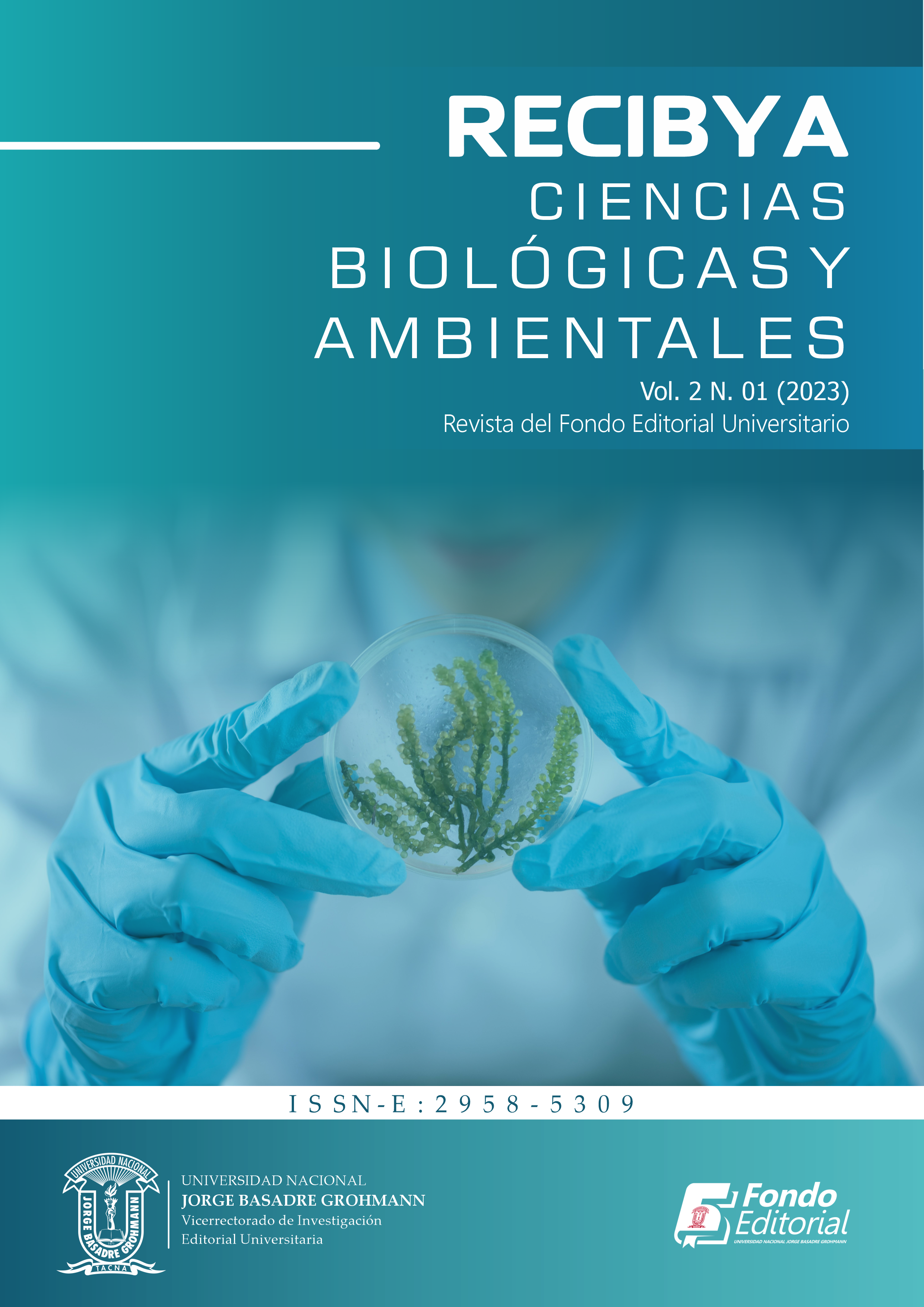a ALTERNATIVE MEANS FOR THE ISOLATION OF AZOTOBACTER NATIVE TO THE DISTRICT OF CALANA, 2024 ALTERNATIVE MEANS FOR THE ISOLATION OF AZOTOBACTER NATIVE TO THE DISTRICT OF CALANA, 2024
Main Article Content
Abstract
Downloads
Article Details
References
Aasfar A, Bargaz A, Yaakoubi K, Hilali A, Bennis I, Zeroual Y, Meftah Kadmiri I. (2021). Nitrogen Fixing Azotobacter Species as Potential Soil Biological Enhancers for Crop Nutrition and Yield Stability. Front Microbiol. 25;12:628379. DOI: 10.3389/fmicb.2021.628379. PMID: 33717018; PMCID: PMC7947814.
Alvarado lbáñez, J. C., & Gutiérrez Araujo, M. K. (2020). Aislamiento y selección de rizobacterias solubilizadoras de fósforo a partir de cultivos de Theobroma cacao L. Revista Científica Dékamu Agropec, 1(1), 15–20. https://doi.org/10.55996/dekamuagropec.v1i1.21
Andrade M. José. (2009). Producción de un biofertilizante a partir de cepas Azotobacter spp. aisladas de plantaciones de Stevia rebaudiana. https://es.scribd.com/doc/24636805/Produccion-de-un-Biofertilizante-a-partir-de-cepas-Azotobacter-spp-Aisladas-de-plantaciones-de-Stevia-Rebaudiana3
Clavijo, Claudia et al, (2012). Aislamiento, caracterización e identificación de bacterias diazotróficas de la rizósfera del cultivo de Olea europea "olivo" en Tacna Perú. Ecol. apl. [online]. Vol.11, n.2, pp. 89-102. http://www.scielo.org.pe/pdf/ecol/v11n2/a06v11n2.pdf
García JE, Maroniche G, Creus C, Suárez-Rodríguez R, Ramirez-Trujillo JA, Groppa MD. (2017). In vitro PGPR properties and osmotic tolerance of different Azospirillum native strains and their effects on growth of maize under drought stress. Microbiol Res. 2:21-29. DOI: 10.1016/j.micres.2017.04.007. Epub 2017 Apr 23. PMID: 28647119.
Guzmán Duchen, Daniel y Montero Torres, Julio. (2021). Interacción de bacterias y plantas en la fijación del nitrógeno. RIIARn [online]. vol.8, n.2, pp.87-101. https://doi.org/10.53287/uyxf4027gf99e
Ibarra Kocfú, J. A., Llica Flores, W. R., & Lazo Ramos, R. S. (2021). Determinación de la influencia de Azotobacter nativos en cultivos de Raphanus sativus como biofertilizante. INGENIERÍA INVESTIGA, 3(1), 578–590. https://doi.org/10.47796/ing.v3i1.482
Jimenez Avella, Diego Javier. (2007). Caracterización molecular de cepas nativas de colombianas de Azotobacter spp. Mediante el análisis de restricción del ADN ribosomal 16s. Pontificia Universidad Javeriana http://www.javeriana.edu.co/biblos/tesis/ciencias/tesis14.pdf
Jiménez DJ, Montaña JS, Martínez MM. (2011). Characterization of free nitrogen fixing bacteria of the genus Azotobacter in organic vegetable-grown Colombian soils. Braz J Microbiol. 42(3):846-58. DOI: 10.1590/S1517-83822011000300003. Epub 2011 Sep 1. PMID: 24031700; PMCID: PMC3768769.
Kennedy A. & Smith L. (1995). Soil microbial diversity and the sustainability of agricultural soil. Plant and soil. Vol 170. Pp 75-86.
Martyniuk, S. and M. Martyniuk. (2003), Occurrence of Azotobacter spp. in some Polish soils. Polish Jour. Environ. Studies 12(3):371–374.
Naik P. & Sakthivel N. (2006). Funtional characterization of a novel hydrocarbonocla stic Pseudomonas sp. strain PUP6 with plant-growth-promoting traits and antifungal potential. Research in Microbiology. 157: 538-546.
Nautiyal C. S. (1999). An efficient microbiological growth medium for screening phosphate solubilizing microorganims. FEMS Microbiology Letters. 170: 265-270.
Padron, Learsy, Duilio Gilberto Torres Rodriguez, Jorge Contreras Olmos, López Marisol, y Carlos Colmenares. (2018). Aislamientos de cepas fijadoras de nitrógeno y solubilizadoras de fósforo en un suelo Alfisol venezolano. Revista Mexicana De Ciencias Agrícolas 3 (2). México, ME:285-97. https://doi.org/10.29312/remexca.v3i2.1463
Reynoso Zárate, Auristela Florencia Cosme de la Cruz, Roberto Carlos Adama Rojas, Enrique Quispe Huincho, Miriam Rocio. (2022). Producción de Biofertilizante Líquido Acelerado. Ministerio de Desarrollo Agrario y Riego – INIA. http://hdl.handle.net/20.500.13036/1275
Romero-Perdomo F, Abril J, Camelo M, Moreno-Galván A, Pastrana I, Rojas-Tapias D, Bonilla R. (2017). Azotobacter chroococcum as a potentially useful bacterial biofertilizer for cotton (Gossypium hirsutum): Effect in reducing N fertilization. Rev Argent Microbiol. 49(4):377-383. DOI: 10.1016/j.ram.2017.04.006. Epub 2017 Aug 31. PMID: 28864227.
Tamme, T, Reinik, M, Roasto, M, et al. (2006). Nitrates and nitrites in vegetables and vegetable-based products and their intakes by the Estonian population. Food Addit Contam; 23(4):355-361.
Tejera, N., C. Lluch, M.V. Martínez-Toledo and J. González-López. (2005), Isolation and characterization of Azotobacter and Azospirillum strains from the sugarcane rhizosphere. Plant and Soil 270 (1–2): 223–232.
Wakarera PW, Ojola P, Njeru EM. (2022). Characterization and diversity of native Azotobacter spp. isolated from semi-arid agroecosystems of Eastern Kenya. Biol Lett. 18(3):20210612. DOI: 10.1098/rsbl.2021.0612. PMID: 35317624; PMCID: PMC8941396.
Zúñiga D. (2012). Manual de Microbiología Agrícola: Rhizobium, PGPRs, Indicadores de Fertilidad e Inocuidad. Ed. Olaya M. Universidad Nacional Agraria La Molina. Lima-Perú.
